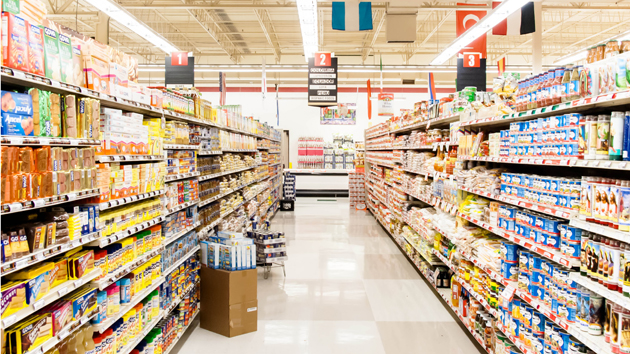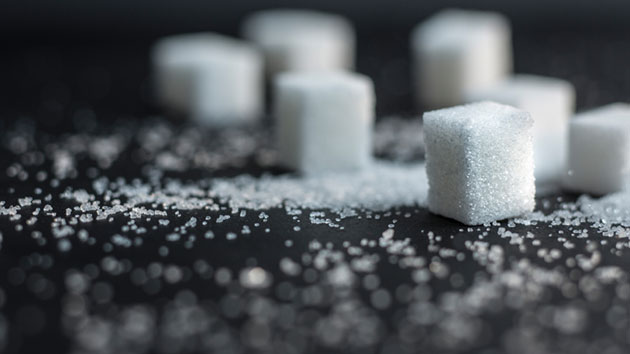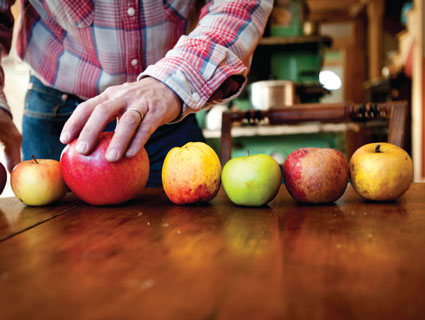
<a href="http://www.shutterstock.com/pic-150161552/stock-photo-chicago-il-august-an-international-supermarket-selling-fresh-grocery-and-frozen-items-in.html?src=1TeCoxt4Us72BxdIVAxnRg-1-10"> Kunal Mehta</a>/Shutterstock
Go down an aisle in your supermarket and pick up a packaged item. Chances are, the contents of that can, bag, box, or pouch were designed in a US military building in the suburbs of Boston.
According to Anastacia Marx de Salcedo’s insightful new book, Combat-Ready Kitchen: How the US Military Shapes the Way You Eat (Current), the effort to nourish faraway GIs with portable, nonperishable, and edible (if not tasty) food has shaped the landscape of our modern food system. How so? Since World War II, the US military’s well-funded food science lab in Massachusetts, the Natick Center, has dominated the development of new food science and technology to create meals with longer shelf life, better flavor and texture, and more convenient packaging. But the Natick Center doesn’t keep its findings to itself. It partners with private corporations (à la ConAgra, General Mills, Hershey, Hormel, Tyson, and Unilever, to name a few) to produce this food for the general public, as well. It’s a win-win for both sides: Corporations get a leg up on the latest and greatest processing and packaging techniques, and the military is ensured a massive supply of rations if war ever breaks out.
If you are feeling queasy about eating food originally created for soldiers, you better watch out: Just about any processed food with a shelf life of more than a couple of days probably has its origins in the Natick Center. Below we outline a few of the biggest military food breakthroughs that you can find in your local grocery store or bodega:
- Canned food: The effort to preserve meat for troops in combat began in the United States in earnest during the Spanish-American War, but it took years before the military understood the science of germs, bacteria, and how food spoils, and could successfully can meat and other perishables.
- Energy and granola bars: After trying trying in vain during World War II to create a chocolate bar that wouldn’t melt, the army developed a fortified fruit bar that was sweet and of “intermediate moisture.” The “fruit bar” evolved into the granola bars and energy bars found in every grocery store and gas station today.
- Packaged, boneless meat: Meat is expensive, especially when you need to feed an entire army. Thus the development of restructured meat: taking the ignored meat chunks and scraps and creating a new, longer-lasting meat. Now many Americans prefer restructured nuggets, patties, and slices over fresh meat from the bone.
- Sliced bread: Making bread is labor-intensive, and the product goes stale and moldy quickly, which is a problem for feeding soldiers who spend days and weeks far from kitchens with ovens. So military food scientists came up with anti-staling additives to make shelf-stable bread, which, after World War II, entered households everywhere, becoming the best thing since, well…
- Dehydrated cheese: Soldiers had such a huge appetite for cheese during the world wars that suppliers had difficulty packaging and shipping enough to meet demand. So the Natick Center went to work to find a better way process cheese for troops. The result? Dehydrated cheese powder. Now it’s found everywhere from the cheese packets in our mac ‘n’ cheese to the Cheeto dust stuck to our fingers.
- TV dinner packaging: In its search for more flexible packaging resistant to changes in temperature and pressure, the Natick Center had a breakthrough when it combined the flexibly of plastic and the vapor-resistance of foil. This led to the plastic and foil “retort pouches” used for everything from heat-and-serve TV dinners to juice pouches, sauce packets, squeeze yogurts, and pet food.
- “Fresh-squeezed” juice and smoothies*: Ever wonder why the “fresh-squeezed,” unpasteurized bottles of fruit and vegetable juice in supermarket coolers last so long without spoiling or making you sick? It turns out their long shelf life owes itself to a military-invented food technology called high-pressure processing. Essentially, pressure is applied to foods at such a high volume that it breaks the bonds holding together bacteria molecules. This process is also used for salsa, guacamole, and “100 percent natural, no preservatives” cold cuts.
- Packaged, prewashed salad: To transport fresh greens to troops, the military developed a way to package produce that controlled oxygen and carbon dioxide levels, slowing down ripening and spoilage.
- Instant coffee: A freeze-drying process initially used for transporting blood and vaccines to battlefield medics during World War II was repurposed as a way to make familiar foods long-lasting and lightweight. That’s how we got instant coffee, as well as the fruit bits in your cereal, the vegetables chunks in your instant noodles, and cake mix—convenient, long lasting, tasty, and brought to you by the US military.
Correction: An earlier version of this article misidentified the kind of juice that undergoes high pressure processing.















